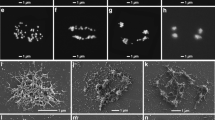Abstract
Accumulating evidence suggests that unicellularArchezoa are the most primitive eukaryotes and their nuclei are of significance to the study of evolution of the eukaryotic nucleus. Nuclear matrix is an ubiquitous important structure of eukaryotic nucleus; its evolution is certainly one of the most important parts of the evolution of nucleus. To study the evolution of nuclear matrix, nuclear matrices ofArchezoa are investigated.Giardia lamblia cells are extracted sequentially. Both embedment-free section EM and whole mount cell EM of the extracted cells show that, like higher eukaryotes, this species has a residual nuclear matrix in its nucleus and rich intermediate filaments in its cytoplasm, and the two networks connect with each other to form a united network. But its nuclear matrix does not have nucleolar matrix and its lamina is not as typical as that of higher eukaryotes; Western blotting shows that lamina ofGiardia and two otherArchezoa Entanzoeba invadens andTrichomonas vaginali all contain only one polypeptide each which reacts with a mammalia anti-lamin polyclonal serum and is similar to lamin B (67 ku) of rnammiia in molecular weight. According to the results and references, it is suggested that nuclear matrix is an early acquisition of the eukaryotic nucleus, and it and the “eukaryotic chromatin” as a whole must have originated very early in the process of evolution of eukaryotic cell, and their origin should be an important prerequisite of the origin of eukaryotic nucleus: in the lamin (gene) family, B-type lamins (gene) should be the ancestral typz and that A-type lamins (gene) might derive therefrom.
Similar content being viewed by others
References
van Driel, R., Humbei, B., de Jong, L., The nucleus, a black box being opened,J. Cell Bioch.,1991,47: 311.
Wen Jianfan, Origin and evolution of nuclear matrix: views from nuclear matrices of several groupg of lower unicellular eukaryotes,Exploration of Nature (in Chinese), 1996, 15: 59.
Cavalier-Smith, T.,Archuebacteria andArchem, Nature, 1989, 339: 100.
Sogin, M. L., Gunderson, J. H., Elwood, H. J. et al., Phylogenetic meaning of the kingdom concept: an unusual ribosomal RNA fromGiardia Inmblia, Science, 1989, 234: 75.
Gupta, R. S., Aitken, K., Falah, M. et al., Cloning ofGiardta lamblia heat shock protein HSP70 homologos: Implications regarding origin of eukaryotic cells and of endoplasmic reticulum,Proc. Natl. Acad. Sci. USA, 1994, 91: 2895.
Kabnick, K. S., Peattie, D. A.,Giardia: A missing link between prokaryotes and eukaryotes,American Scientist, 1991, 79: 34.
Li Jingyan, Diplomonads and the exploration on the origin of cell nucleus,Zoo. Res. (in Chinese),1996, 17:275.
Zhai, Z. H., Nickerson, J. A., Krochmalnic, G. et al., Alterations in nuclear matrix structure after adenovirus infection,J. Virol., 1987, 61: 1007.
Fey, E. G., Krochmalnic, G., Penman, S., The non-chromatin substructures of the nucleus: the ribonucleoprotein (RNPIcontaining and RNP-depleted matrices analyzed by sequential fractionation and resinless section electron microscopy,J. Cell Biol., 1986, 102: 1654.
Towbin, H., Staehelin, T., Gordon, J., Electrophoretic transfer of proteins from polyacrylamide gels to nitrocellulose sheets: procedure and some application,Proc. Natl. Sct. USA, 1979, 76: 4350.
Takayanagi, S., Morimura, S., Kusaoke, H. et al., Chromosomal structure of the halophilic archaebacteriumHalobacterium salinariurn, J. Bacteriol., 1992, 174: 7207.
Stick, R., Hausen, P., Changes in the nuclear lamina composition during early development ofXenopus laevis, Cell, 1985, 41: 191.
Lehner, C. F., Stick, R., Eppenberger, H. M. et al., Differential expression of nuclear lamin proteins during chicken development,J. Cell Biol., 1987, 105: 577.
Steward, C., Burke, B., Teratocarcinoma stem cells and early mouse embryos contain only a single major lamin polypeptide closely resembling lamin B,Cell, 1987, 51: 383.
Stick, R., The gene structure ofXenopus nuclear lamin A: A model for the volution of A-type from Btype lamina by exon shuffling,Chromasoma, 1992, 101: 566.
Author information
Authors and Affiliations
Additional information
Project supported by the National Natural Science Foundation of China (Grant No. 3870254).
Rights and permissions
About this article
Cite this article
Wen, J., Li, J. Nuclear matrix of the most primitive eukaryoteArchezoa . Sci. China Ser. C.-Life Sci. 41, 479–487 (1998). https://doi.org/10.1007/BF02882885
Received:
Issue Date:
DOI: https://doi.org/10.1007/BF02882885




